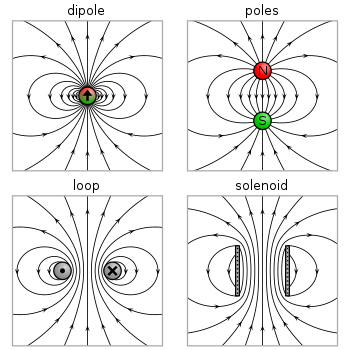Magnetic dipole

Inelectromagnetism,amagnetic dipoleis the limit of either a closed loop ofelectric currentor a pair of poles as the size of the source is reduced to zero while keeping themagnetic momentconstant.
It is a magnetic analogue of theelectric dipole,but the analogy is not perfect. In particular, a truemagnetic monopole,the magnetic analogue of anelectric charge,has never been observed in nature. However, magnetic monopolequasiparticleshave been observed as emergent properties of certain condensed matter systems.[2]Moreover, one form of magnetic dipole moment is associated with a fundamental quantum property—thespinofelementary particles.
Because magnetic monopoles do not exist, the magnetic field at a large distance from any static magnetic source looks like the field of a dipole with the same dipole moment. For higher-order sources (e.g.quadrupoles) with no dipole moment, their field decays towards zero with distance faster than a dipole field does.
External magnetic field produced by a magnetic dipole moment[edit]


Inclassical physics,the magnetic field of a dipole is calculated as the limit of either a current loop or a pair of charges as the source shrinks to a point while keeping themagnetic momentmconstant. For the current loop, this limit is most easily derived from thevector potential:[3]
whereμ0is thevacuum permeabilityconstant and4π r2is the surface of a sphere of radiusr. The magnetic flux density (strength of the B-field) is then[3]
Alternatively one can obtain thescalar potentialfirst from the magnetic pole limit,
and hence the magnetic field strength (or strength of the H-field) is
The magnetic field strength is symmetric under rotations about the axis of the magnetic moment. In spherical coordinates, with,and with the magnetic moment aligned with the z-axis, then the field strength can more simply be expressed as
Internal magnetic field of a dipole[edit]
The two models for a dipole (current loop and magnetic poles), give the same predictions for the magnetic field far from the source. However, inside the source region they give different predictions. The magnetic field between poles is in the opposite direction to the magnetic moment (which points from the negative charge to the positive charge), while inside a current loop it is in the same direction (see the figure to the right (above for mobile users)). Clearly, the limits of these fields must also be different as the sources shrink to zero size. This distinction only matters if the dipole limit is used to calculate fields inside a magnetic material.
If a magnetic dipole is formed by making a current loop smaller and smaller, but keeping the product of current and area constant, the limiting field is
whereδ(r)is theDirac delta functionin three dimensions. Unlike the expressions in the previous section, this limit is correct for the internal field of the dipole.
If a magnetic dipole is formed by taking a "north pole" and a "south pole", bringing them closer and closer together but keeping the product of magnetic pole-charge and distance constant, the limiting field is
These fields are related byB=μ0(H+M),where
is themagnetization.
Forces between two magnetic dipoles[edit]
The forceFexerted by one dipole momentm1on anotherm2separated in space by a vectorrcan be calculated using:[4]
whereris the distance between dipoles. The force acting onm1is in the opposite direction.
The torque can be obtained from the formula
Dipolar fields from finite sources[edit]
Themagnetic scalar potentialψproduced by a finite source, but external to it, can be represented by amultipole expansion.Each term in the expansion is associated with a characteristicmomentand a potential having a characteristic rate of decrease with distancerfrom the source. Monopole moments have a1/rrate of decrease, dipole moments have a1/r2rate, quadrupole moments have a1/r3rate, and so on. The higher the order, the faster the potential drops off. Since the lowest-order term observed in magnetic sources is the dipole term, it dominates at large distances. Therefore, at large distances any magnetic source looks like a dipole of the samemagnetic moment.
Notes[edit]
- ^I.S. Grant, W.R. Phillips (2008).Electromagnetism(2nd ed.). Manchester Physics, John Wiley & Sons.ISBN978-0-471-92712-9.
- ^Magnetic monopoles spotted in spin ices,September 3, 2009.
- ^abChow 2006,pp. 146–150
- ^D.J. Griffiths (2007).Introduction to Electrodynamics(3rd ed.). Pearson Education. p. 276.ISBN978-81-7758-293-2.
- ^Furlani 2001,p. 140
- ^K.W. Yung; P.B. Landecker; D.D. Villani (1998)."An Analytic Solution for the Force between Two Magnetic Dipoles"(PDF).RetrievedNovember 24,2012.
{{cite journal}}:Cite journal requires|journal=(help)
References[edit]
- Chow, Tai L. (2006).Introduction to electromagnetic theory: a modern perspective.Jones & Bartlett Learning.ISBN978-0-7637-3827-3.
- Jackson, John D. (1975).Classical Electrodynamics(2nd ed.).Wiley.ISBN0-471-43132-X.
- Furlani, Edward P. (2001).Permanent Magnet and Electromechanical Devices: Materials, Analysis, and Applications.Academic Press.ISBN0-12-269951-3.
- Schill, R. A. (2003). "General relation for the vector magnetic field of a circular current loop: A closer look".IEEE Transactions on Magnetics.39(2): 961–967.Bibcode:2003ITM....39..961S.doi:10.1109/TMAG.2003.808597.


![{\displaystyle \mathbf {B} ({\mathbf {r} })=\nabla \times {\mathbf {A} }={\frac {\mu _{0}}{4\pi }}\left[{\frac {3\mathbf {r} (\mathbf {m} \cdot \mathbf {r} )}{r^{5}}}-{\frac {\mathbf {m} }{r^{3}}}\right].}](https://wikimedia.org/api/rest_v1/media/math/render/svg/0991963d60a114ec41900b0eec04c944d03bb603)

![{\displaystyle {\mathbf {H} }({\mathbf {r} })=-\nabla \psi ={\frac {1}{4\pi }}\left[{\frac {3\mathbf {\hat {r}} (\mathbf {m} \cdot \mathbf {\hat {r}} )-\mathbf {m} }{r^{3}}}\right]={\frac {\mathbf {B} }{\mu _{0}}}.}](https://wikimedia.org/api/rest_v1/media/math/render/svg/013db70805fbb46e718a5ac0fc04faa2f63dcd99)


![{\displaystyle \mathbf {B} (\mathbf {r} )={\frac {\mu _{0}}{4\pi }}\left[{\frac {3\mathbf {\hat {r}} (\mathbf {\hat {r}} \cdot \mathbf {m} )-\mathbf {m} }{|\mathbf {r} |^{3}}}+{\frac {8\pi }{3}}\mathbf {m} \delta (\mathbf {r} )\right],}](https://wikimedia.org/api/rest_v1/media/math/render/svg/fe67ea7be3f7de2cc2f007ff3193b08520455b4d)
![{\displaystyle \mathbf {H} (\mathbf {r} )={\frac {1}{4\pi }}\left[{\frac {3\mathbf {\hat {r}} (\mathbf {\hat {r}} \cdot \mathbf {m} )-\mathbf {m} }{|\mathbf {r} |^{3}}}-{\frac {4\pi }{3}}\mathbf {m} \delta (\mathbf {r} )\right].}](https://wikimedia.org/api/rest_v1/media/math/render/svg/a1b635de5e52b7fd68571a72866d50392b0b7213)


![{\displaystyle \mathbf {F} (\mathbf {r} ,\mathbf {m} _{1},\mathbf {m} _{2})={\dfrac {3\mu _{0}}{4\pi r^{5}}}\left[(\mathbf {m} _{1}\cdot \mathbf {r} )\mathbf {m} _{2}+(\mathbf {m} _{2}\cdot \mathbf {r} )\mathbf {m} _{1}+(\mathbf {m} _{1}\cdot \mathbf {m} _{2})\mathbf {r} -{\dfrac {5(\mathbf {m} _{1}\cdot \mathbf {r} )(\mathbf {m} _{2}\cdot \mathbf {r} )}{r^{2}}}\mathbf {r} \right],}](https://wikimedia.org/api/rest_v1/media/math/render/svg/d505434bbe3f60c36a43d3769e7d612c6fb1f27a)
